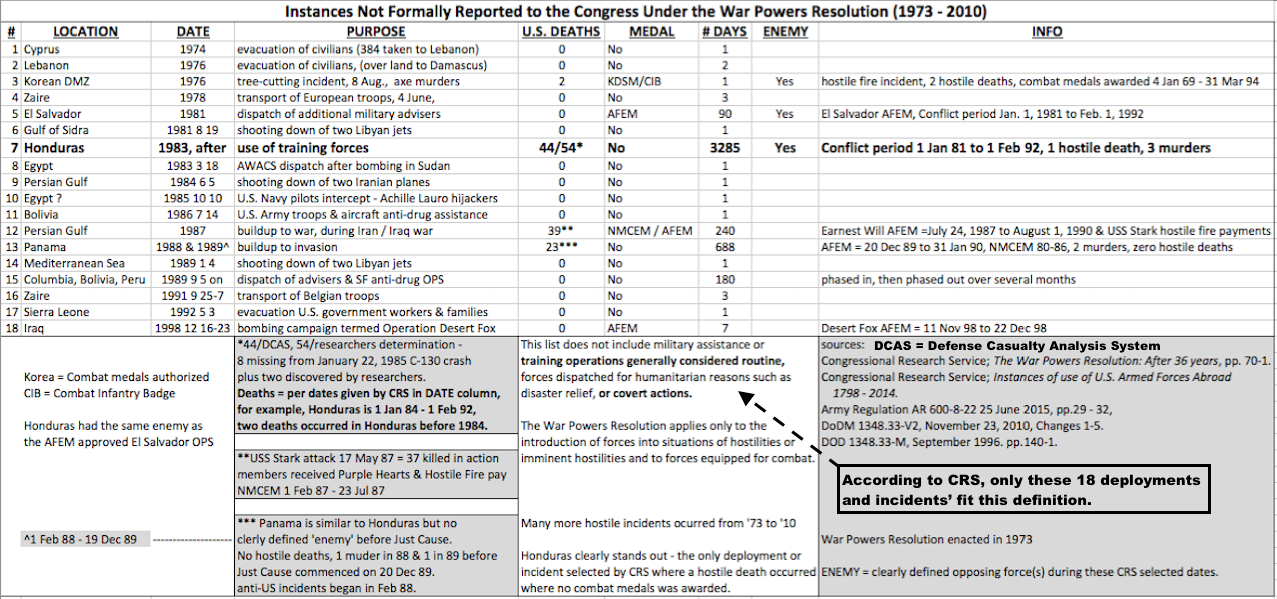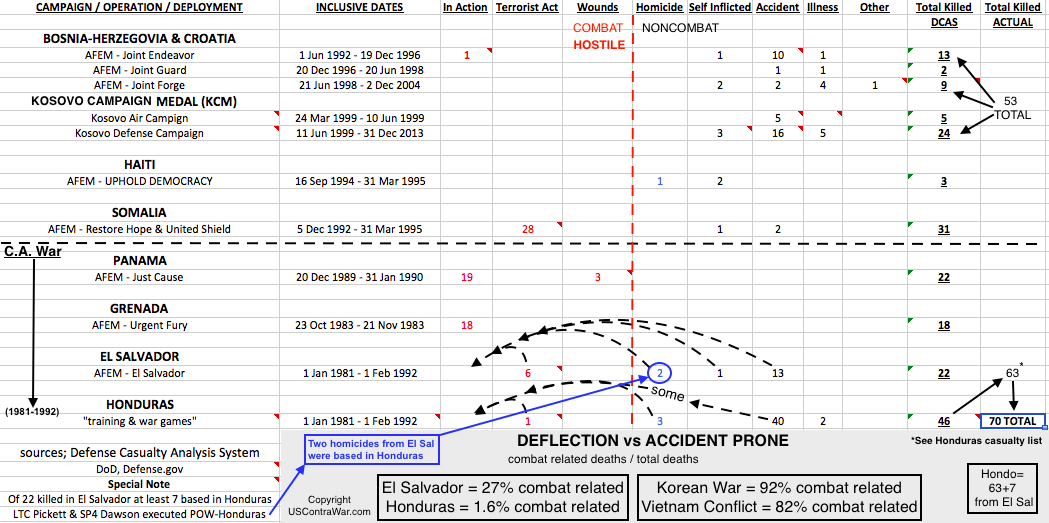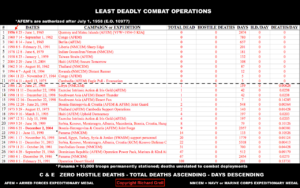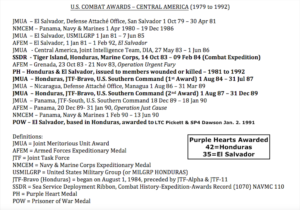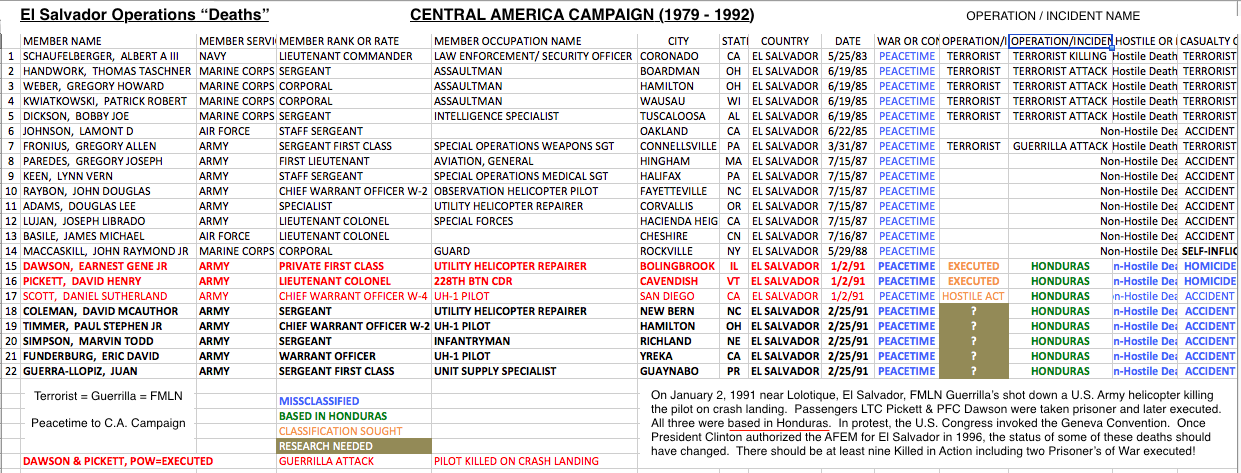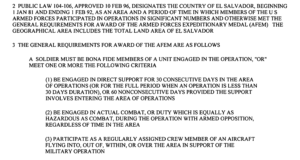“The (Nicaraguan) Sandinista regime has been waging war against its neighbors since August of 1979. This has included military raids into Honduras and Costa Rica which still continue today”. President Ronald Reagan, May 9, 1984, address to the Nation
“Nicaragua is waging three wars in Central America. Right now there are guerrilla movements in Nicaragua which are waging war in El Salvador, Guatemala, and Honduras” Rep. Newt Gingrich (R-GA), House floor, June 27, 1985
“Nicaragua’s Interior Minister, Tomas Borge Martinez, said recently that ‘a real state of war’ existed along the border with Honduras.” (Raymond Bonner, NYT GI’s Join Hondurans in Touchy Region, August 5, 1982)
“Nicaragua has also been equipping, training, organizing, and infiltrating guerrillas and agents into Honduras, it has launched direct attacks into that country using its regular armed forces.” (Sec. of State George Shultz address before the VFW, March 3, 1986)
————————————————————————————-
NEW UPDATE (2023) – The VFW has voted to support our mission (see about half way down this page)
In the words of the VFW – “Americans have lost their lives in some 85 wars and assorted military actions in the past 234 years. Most of the casualties occurred in a dozen or so major wars. But that does not lessen the sacrifice of those killed in the numerous and mostly forgotten minor expeditions in the far-flung corners of the globe. Whenever any American in uniform is killed by hostile enemy action it is meaningful, and that loss must be remembered and forever recognized.” (VFW Magazine, June 2009 p.21)
———————————————————————————–
Central America War 1979 – 1992
USContraWar is published for the estimated 300,000 U.S. military members deployed to Honduras during the Central America War from October 1, 1979 to February 1, 1992, their families and others interested in what U.S. troops were actually doing during the conflict. The war includes the Defense of the Nicaraguan Revolution (1979 – 1990) and the correlated Contra War (1980 – 1990), the El Salvadoran civil war (1981 – 1992), the Grenada Rescue Urgent Fury (1983), the Panama Invasion Just Cause (1989 – 1990) and significant terrorist attacks, guerrilla / insurgent war activity throughout Central America.
Because the U.S. Government claims that Honduras was safe for ‘training and war games’ and that no U.S. Service Members deployed to Honduras were engaged in combat or combat support; we at USContraWar are advocating for conflict recognition in the form of an Armed Forces Expeditionary Medal (AFEM) or Central America Campaign Medal (CACM) and the National Defense Service Medal (NDSM) by the United States Government for service during the decade that ended communist advances into the Western Hemisphere allowing democracy to flourish in Central America.
Our research has concluded that at least:
forty-six Purple Hearts were awarded,
seventy service members were killed in Honduras or were stationed in Honduras,
one U.S. military member was Killed In Action in Honduras,
two-hundred terrorist and Nicaraguan military attacks occurred in Honduras.
The following chart raises several important questions. For example, why aren’t the Honduran deployments officially recognized as a foreign campaign and why aren’t these deployments listed in Service Members records? The clearly defined enemy was Nicaragua with Soviet/Cuban support of communist expansion throughout Latin America, dozens of Purple Hearts were awarded to U.S. Service Members stationed in Honduras, two Honduras based U.S. Service Member received the POW Medal and at least one member was killed in action in Honduras; yet the U.S. Government classifies these deployments as training and war games. U.S. troops were deployed to Honduras beginning in 1980 and remained throughout the conflict. Some U.S. troops are still stationed in Honduras.
The chart further details important U.S. foreign military deployments and instances that were not reported to Congress under the War Powers or Arms Export Control Acts selected by the Congressional Research Service (CRS) from the end of the Vietnam War up to 2010. Honduras is the only deployment or instance where Purple Hearts, POW medals and Hostile Fire Pay were authorized, but no campaign or expeditionary medal was issued. Honduras is also the only long-duration deployment selected by CRS.
At USContraWar you will find extensive information regarding military and terrorist attacks against U.S. troops, citizens and assets in Honduras and throughout the isthmus during the Central America War.
Our main goal at USContraWar is to petition the U.S. Congress and the Executive Branch to issue an AFEM or CACM, the NDSM, and other combat recognitions to U.S. troops who served in Honduras and Central America during the war ultimately leading to the creation and issuance of the Central America Campaign Medal. This is important because we believe it is critical to establish accurate databases of U.S. casualties that occurred and instances where U.S. troops in Honduras and Central America were subjected to hostile fire, explosive devices or conducted offensive operations against the enemy.
U.S. military members who deployed to Honduras during the C. A. War do not have these deployments or related awards listed in their official military records. Imminent Danger Pay (IDP) was not authorized.
The following DoD report clearly establishes imminent danger in Honduras:
9 Dec 83 Defense Intelligence Agency report; Subj: DIA TERRORISM WARNING REPORT 83-1 FOR US FORCES LOCATED IN HONDURAS 1. DIA ASSESSES AVAILABLE INFORMATION ON TERRORIST CAPABILITIES AND INTENTIONS AGAINST US FORCES LOCATED IN HONDURAS AS SUFFICIENTLY SERIOUS TO WARRANT HEIGHTENED COMMAND ATTENTION AND SECURITY PRECAUTIONS. 2. …AN INCREASING POSSIBILITY OF AN ATTACK AGAINST US MILITARY PERSONNEL IN HONDURAS… 4. …US FORCES IN HONDURAS FACE A HEIGHTENED THREAT…THE HONDURAS LEFT PROBABLY FEELS PRESSURE TO PERFORM SOME “OFFENSIVE ACTION” AGAINST THE US…US FORCES IN HONDURAS SHOULD EXERCISE CAUTION AND MAINTAIN INCREASED SECURITY AWARENESS…
This next chart visually explains what happens when U.S. military combat forces are deployed to a hostile foreign country where Congress has outlawed these deployments.
Compare and contrast similar foreign military operations and you will see that Honduras remains the only foreign deployments classified as ‘training and war games’ where imminent danger existed, hostilities persisted, and Purple Hearts were issued, yet the U.S. maintains this was all for training and games.
Here is DoD’s position: DOD Response 20 Apr 2018 Office of the Assistant Secretary of Defense; When asked to create a Central America Campaign Medal “the Department of Defense (DoD) cannot support such a request” because “campaign medals recognize deployed participants in large-scale or long-duration combat operations, and are associated with the highest level of personal risk and hardship. U.S. military training exercises conducted in Honduras during the 1980’s and early 1990’s were not qualifying combat operations.”
In 2014, DoD had 54 designated IDP (combat) areas world-wide, many with zero fatalities, few if any wounded and little or no hostile attacks reported in many years, yet everyone deployed received IDP, combat awards and Combat Zone Tax benefits.
U.S. troops were deployed to Honduras as a protective shield as confirmed by General Gustavo Alvarez Martinez, Honduran CINC, who stated “We are at war with the communists who have invaded our organizations” (UPI, Honduran Army Chief Says U.S. Presence Protects Nation, January 24, 1984); the title of this article is a quote by General Martinez who claimed that U.S. troops who were deployed to Honduras were protecting Honduras (and therefore the U.S.) against Soviet/Cuban support of communist Nicaragua and insurgent aggression throughout Central America.
— QUICK FACTS —
The Executive Branch declared a National Emergency against Nicaraguan on May 1, 1985 which lasted until March 17, 1990. The U.S. also imposed a trade embargo and terminated its Treaty of Friendship, Commerce and Navigation with Nicaragua during this same period. The U.S. took these steps to “deal with the unusual and extraordinary threat created by the aggressive actions of the Government of Nicaragua in Central America…and therefore to the United States.” (EO 12513 May 1, 1985; U.S. Dept. of State memo subj. Economic Sanctions Against Nicaragua, John D. Blackan, May 8, 1985) Other related threats existed from 1979 to 1992. Also, DOD began issuing Hostile Fire Pay to U.S. military members serving in El Salvador on October 1, 1979 which should be the starting date of the CA War. The Honduras portion of the CA War remains the only such Presidential National Emergency declaration against a foreign enemy where U.S. forces were dispatched and no Campaign or Expeditionary medal was awarded.
At least seventy U.S. military members were killed in Honduras or were based in Honduras during the war-which is more U.S. casualties then during the Panama Invasion, the Grenada Rescue and El Salvadoran civil war-combined. The Honduras portion of the C.A. War remains the only conflict not recognized by the U.S. Government as a combat zone, therefore no AFEM or NDSM have been issued. Countless additional U.S. troops were wounded, in Honduras, during attacks by terrorists and foreign military forces operating inside Honduras. In comparison, the Bosnia / Kosovo Campaign (1992-2013) has one hostile death yet all who deployed received proper recognitions.
The above chart shows how many U.S. military operations earned combat recognitions with zero hostile deaths; several with zero fatalities total. Most are not large-scale or long-duration! As of 2016, there are eleven combat operations with zero fatalities. In comparison, the Quemoy and Matsu Islands combat expedition from 1956 to 1963 was 2,474 days long with zero fatalities. On the opposite end of the scale, Operation Eagle Pull, in Cambodia in 1975, was three days long with zero fatalities. Both earned combat expedition status and are therefore ‘remembered and forever recognized.’ Another example of a short combat expedition was the five day Congo operation in 1964 with zero deaths. It is blatantly clear that neither duration nor hostilities are factors in determining when to issue combat recognitions. The Honduran deployments are not listed because there is at least one hostile death.
CWO2 JEFFRY SCHWAB was killed on January 11, 1984 by Nicaraguan government troops after his helicopter was shot down, followed by additional small arms fire when he was fatally struck in the head by a round. The Nicaraguan government claimed they shot his helicopter down over Nicaraguan air space. The U.S. Government claimed they were flying over Honduran air space when they were shot down. Two other U.S. troops escaped, apparently without injuries. Upon rescue attempts of the two survivors, U.S. troops allegedly came under additional hostile fire. This is the only listed Honduran based American military casualty the U.S. government has publicly acknowledged AS RELATED TO THE CONFLICT and the incident is listed as a terrorist act during peace time. Nicaraguan troops were not part of a terrorist organization or group. Jeff Schwab’s Purple Heart reads “FOR WOUNDS RECEIVED IN ACTION IN HONDURAS ON 11 JANUARY 1984 WHICH RESULTED IN DEATH.” Jeff saved the lives of his two passengers and has not been posthumously awarded a combat award for valor. Central Command’s CINC General Paul Gorman’s letter to Schwab’s widow reads in part, “Chief Warrant Officer Jeffrey C. Schwab, whose cool courage under fire, and skilled airmanship saved the lives of his passengers.” (letter dated 30 January 1984). All three were paid Hostile Fire Pay (HFP).
Of the twenty-two U.S. military members killed in El Salvador during the war, as many as twelve were based in Honduras including members of the 228th Aviation Regiment LTC David Pickett, CWO4 Daniel Scott and SP4 Earnest Dawson. Their helicopter was shot down on January 2, 1991 by communist guerrillas near Lolotique, El Salvador on the return leg of a round-trip flight from Soto Cano Air Base, Honduras to San Salvador, El Salvador. Scott was killed while piloting the helicopter. LTC Pickett and PFC Dawson survived the crash, were captured by the enemy and later executed as wounded Prisoners of War. LTC Pickett was posthumously awarded the POW medal and SP4 Dawson’s family has finally been honored with his POW medal.
These two incidents alone establish that regular military conventional U.S. combat forces, based in Honduras, were conducting combat missions in support of the Central America War. As with the Bosnia / Kosovo low intensity conflict with one hostile death, all U.S. service members who deployed to Honduras should have their service records updated with proper combat recognitions and listed deployments.
Not including the numerous individual awards such as the Purple Heart or POW medal, there is no actual group combat medal issued to U.S. Service Members deployed to Honduras. The JMUA is not a combat medal, but is listed here to establish the importance of those operations. JTF-11, Headquartered at Palmerola AB, became operational on 13 August 1983, was later renamed JTF-Alpha and terminated when JTF-Bravo was activated on 01 August 1984. JTF-Bravo is still active. All JTF’s operating at Palmerola (Soto Cano) during the CA War period have been awarded the JMUA.
NEW UPDATE – The Veterans of Foreign Wars (VFW) agrees with the conclusions at USContraWar! In July 2023, during its annual national convention in Phoenix, the VFW voted to adopt Resolution 419 – Honduras. THANK YOU! See the text of the Resolution here…
[Resolution No. 419. HONDURAS
WHEREAS, the vision of the Veterans of Foreign Wars (VFW) of the United States is to, “Ensure that veterans are respected for their service, always receive their earned entitlements, and are recognized for the sacrifices they and their loved ones have made on behalf of this great country;” and
WHEREAS, the VFW believes all military members and veterans who serve or have served in hostile environments should be appropriately recognized; and
WHEREAS, the United States (U.S.) military maintained a presence in Honduras throughout and beyond the 1980s providing training to and conducting military exercises with the host nation military; and
WHEREAS, the buildup and presence of U.S. troops served as a deterrent to Nicaraguan aggression in the region and also a means of building support for democratic values via civil action in Honduran communities; and
WHEREAS, U.S. troops were equipped with live ammunition and assisted the Honduran military in training and combat support capacities; and
WHEREAS, U.S. troops reported experiencing hostile fire and imminent danger; and
WHEREAS, at least one U.S. service member received a Purple Heart because of terrorist activity; and
WHEREAS, U.S. troops lost their lives while conducting various duties due to terrorist activity and other hazardous circumstances; now, therefore
BE IT RESOLVED, by the Veterans of Foreign Wars of the United States, that we strongly urge Congress to issue an Armed Forces Expeditionary Medal, or similar recognition of having served in an area of hostility, to all U.S. troops who served in Honduras from 1981 to 1992.
Submitted by Commander-in-Chief
To Committee on NATIONAL SECURITY & FOREIGN AFFAIRS by the 124th National Convention of the Veterans of Foreign Wars of the United States.]
*Please support the VFW’s mission by contacting your local Congressional Representatives and requesting that they support VFW Res. 419 Honduras.
The following chart details those who perished in El Salvador during that portion of the CA War. As many as twelve were actually stationed in Honduras, mostly at Palmerola Air Base (later renamed Soto Cano AB) and were dispatched on combat missions to El Salvador. Hence, all military members who were deployed at Palmerola AB and were in direct support of any personnel or unit supporting these missions to El Salvador, where these flights originated, were acting in direct support of El Salvador AFEM combat missions and therefore qualify for CZ or QHDA benefits and recognitions as outlined in FMR 7000.14-R (see regulation details further down in this article).
During the Central America War, more than 300 U.S. troops were killed in the extended theatre of operation.
An estimated one hundred thousand people died as a direct result of the Central America War.
Over 200 documented military and terrorist attacks occurred above or on Honduran territory during the Central America War; many by Nicaraguan communist government troops and El Salvadoran leftist guerrilla forces directed against American troops while operating in a combat role and equipped for combat in Honduras. Countless attacks remain undocumented or secret.
An estimated 300,000 U.S. troops, many equipped for combat with ammunition, were deployed to Honduras during the Central America War to protect U.S. interests, form a protective shield and conduct military operations and training. There was no formal treaty or Congressional law authorizing the deployments of U.S. troops equipped for combat to Honduras, therefore no Executive Branch combat recognitions.
“In Honduras, Cuba has just now completed the same unification operations: Parties have been joined together in a national directorate committed to armed struggle. A new attempt to overthrow an established government by force is underway.” (Statement before the Subcommittee on Western Hemisphere Affairs of the Senate Foreign Relations Committee on December 14, 1981 by Ambassador Thomas O. Enders, Assistance Secretary of Inter-American Affairs)
During these Executive Branch declared ‘training and war games’ where no combat occurred according to the Pentagon, an estimated forty-two Purple Hearts were issued to U.S. troops serving in Honduras during the C.A. War period; yet at least 70 were killed and many dozens more were wounded by hostile fire and explosive devices. For example, on July 13, 1989 in La Cieba, seven Military Policemen of the 549th MP Company, from Panama, were wounded when a bomb was thrown at them while they were crossing a bridge. The MP’s were based out of Palmerola (renamed Soto Cano) Air Base protecting engineers who were on a road building project called Fuertes Caminos. No Purple Hearts were awarded to these seven MP’s wounded during this attack.
Many documented and countless more undocumented U.S. troops were subjected to hostile fire, explosive devices and imminent danger yet have not received proper combat honors and recognition by the United States Government.
Federal Management Regulation DoD 7000.14-R Vol. 7A, Ch 44 Dec. 2013 provides examples of when military personnel qualify for Combat Zone (CZ) or Qualified Hazardous Duty Area (QHDA) tax exclusions under direct support of combat military operations. These include: 1) when personnel render service on a supply vessel transporting supplies to the CZ or QHDA, 2) “If an aircraft in a nearby country outside the CZ or QHDA is used to transport supplies and personnel into the CZ or QHDA, then the members of the ground crew who load the aircraft and the maintenance personnel who maintain the aircraft,” including those “members who maintain and control the airstrip (e.g., as a meteorologist or air traffic controller) are performing services in direct support of military operations in the CZ or QHDA qualify for the tax exclusion.” Furthermore all personnel in the neighboring country outside the combat zone “who support and assist other members of that unit or installation who serve in direct support of military operations in a CZ or QHDA” are considered to be serving in direct support of military operations in a CZ or QHDA. “Generally, all members who serve in support of operations at an installation (outside the CZ or QHDA) where some members serve in direct support of military operations in a CZ or QHDA are considered to be serving in direct support of military operations in a CZ or QHDA (e.g., unit or installation personnel for an airstrip would qualify).”
Federal Management Regulation DoD 7000.14-R combined with the below MILPER Message NR 96-104 (Public Law 104-106) clearly establish who is eligible for the El Sal AFEM. Honduran deployments of American troops were excluded from these recognitions and correlated benefits for long-forgotten political reasons.
In May, 1996, President Clinton signed the National Defense Authorization Act (Public Law 104-106), which in part, created the El Salvador Armed Forces Expeditionary Medal for some 5,000 U.S. troops who served in El Salvador during that portion of the CA War where twenty-two U.S. troops were killed. During the same period of the El Salvador AFEM, sixty-three U.S. troops were killed in Honduras. As many as twelve of the twenty-two killed in El Salvador were actually based in Honduras and were sent from Honduras to support combat missions in El Salvador further proving a Direct Combat Role of U.S. troops based in Honduras.
Once the El Salvador AFEM became law, all combat and personnel involved in direct support of military operations as outlined above in FMR 7000.14-R, even in surrounding countries, legally became eligible for CZ or QHDA benefits and recognitions. Unfortunately, most of this never happened.
But Honduras should have been designated its own Combat Zone or Qualified Hazardous Duty Area authorizing IDP! The following State Department document establishes that regular Nicaraguan military forces were launching attacks deep inside Honduran territory and that Honduran military forces were engaged in heavy combat with Nicaragua while U.S. forces were nearby and aiding Honduran forces. The Nicaraguan Contra rebels or freedom fighters were launching attacks into Nicaragua from these same Honduran bases. The U.S. military presence in the area alone acted as a protective shield for the Honduran military and Nicaraguan Contra rebels engaged in combat in the area. Furthermore, U.S. helicopters were used to transport Honduran soldiers during these battles in direct support of a friendly foreign nation involved in a regional conflict, for example. See also the Military & Terrorist Attacks in Honduras page for additional CZ/QHDA data establishing that Honduras was an imminent danger area.
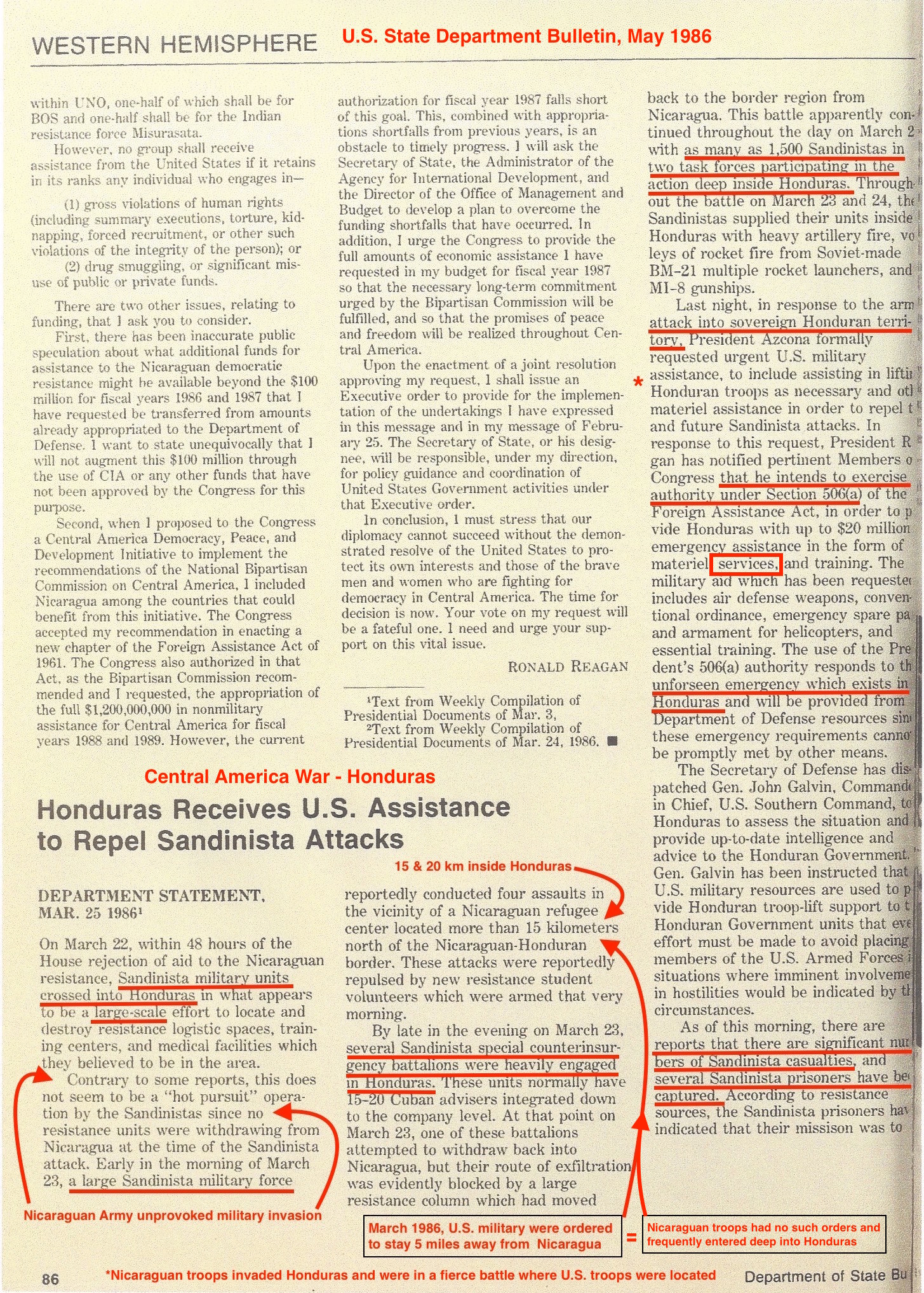
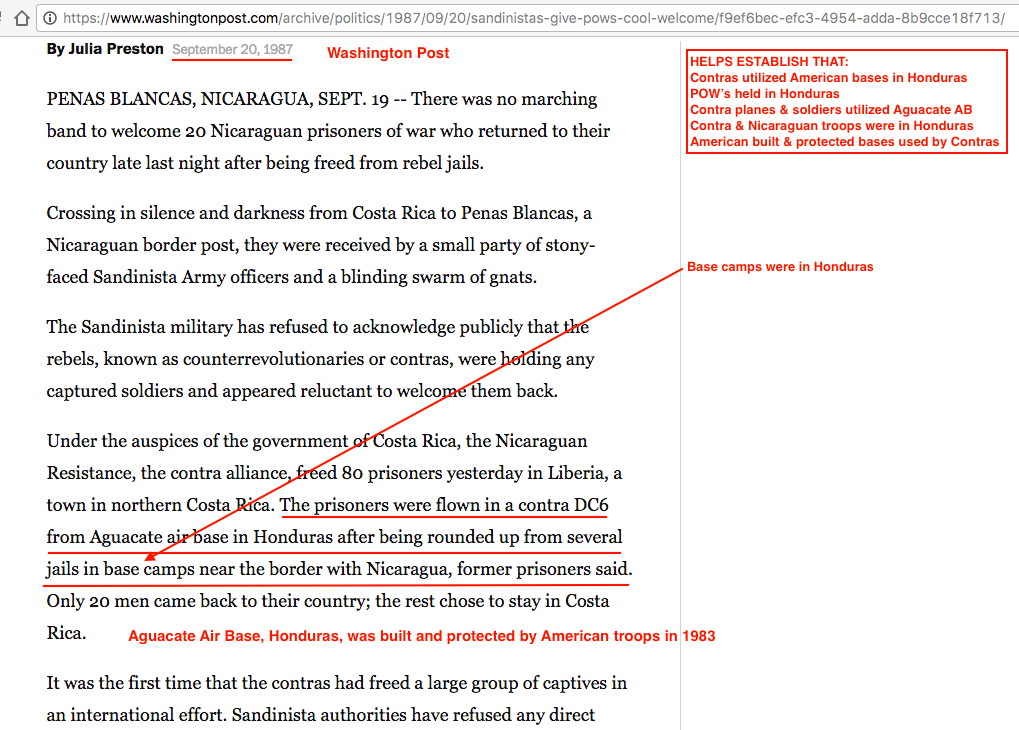
How can you help? Support VFW Res. 419 – Honduras!
Please help us advocate for recognition as Veterans of this Low-Intensity Conflict by sending a letter to your U.S. Congress or Senate representative in support of our mission by asking Congress to issue an Armed Forces Expeditionary Medal to all U.S. troops who served in Honduras from 1981 to 1992. This will help the veterans and families of the killed and wounded, those veterans attempting to receive proper combat honors and recognition for their sacrifices during the decade that ended Soviet communism. Support VFW Res. 419!
WAR? LOW-INTENSITY CONFLICT? IMMINENT DANGER AREA?
TELL YOUR REPRESENTATIVE WHAT YOU THINK!

